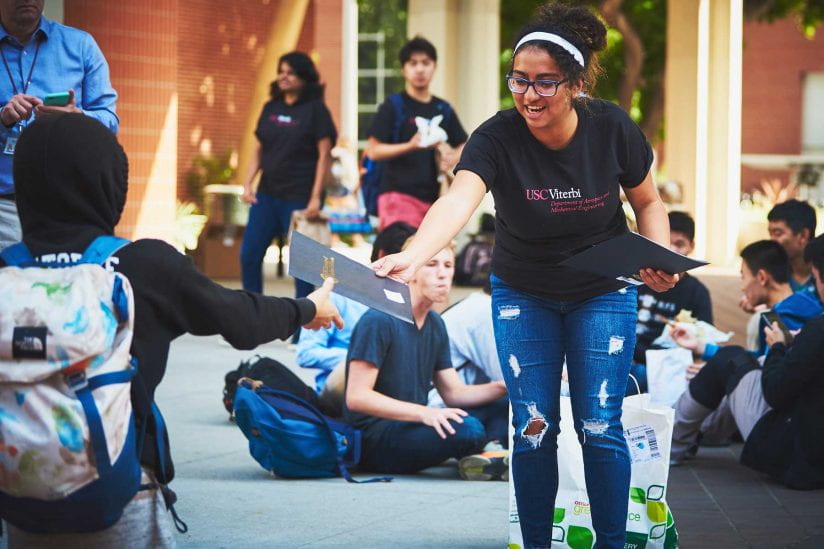The 11th-graders toed the chalk line, cradling paper airplanes before launching them over the courtyard at Von KleinSmid Center on the USC University Park Campus. Cheers and groans followed as each handmade aircraft soared and plummeted to the concrete.
USC junior Leslie Guandique darted out to the farthest landing and marked the winning distance at 142 feet.
“I haven’t been able to fly one past 30 feet,” the USC Viterbi School of Engineering student later confessed. “So it was surprising to see the students did so well. I was really impressed.”
The creative competition was the brainchild of Guandique, who wanted to give high schoolers in the Viterbi Adopt-a-School, Adopt-a-Teacher (VAST) program a real and interactive experience in aerospace engineering.
She even gave their teachers a math challenge beforehand to help them introduce the concepts, asking each young contender to submit documentation on the process and reasoning for the construction of their paper plane.
“I wanted to give them an idea of what it is like to think like an engineer.”
Guandique said outreach programs like VAST are vital to give science-inclined students the chance to explore the many different STEM fields. It’s an opportunity the Alhambra native didn’t have as a youth obsessed with science yet uninformed about how to turn her passion into a profession.
“I knew I loved science but never had guidance in high school about classes and extracurriculars I needed to take,” she said. “I didn’t get the exposure to what was out there or get to talk to engineers and ask them questions.
“These outreach programs actually make a huge difference in someone’s career path.”
The daughter of an El Salvadoran refugee and a Mexican immigrant, Guandique said her parents encouraged her fascination with the field.
“My mom didn’t know a lot about science, but she took me to the California Science Center a lot. I would watch Star Trek with my dad from a very young age. I thought it was so cool, and would start reading more about it. … Honestly, it’s probably because of Star Trek.”
Summer STEM research
It was another STEM outreach program at USC that gave her the jumpstart she needed in the field. While at East Los Angeles College pushing toward a transfer to USC, Guandique landed a spot in the USC Summer STEM Research Experience program. That work in a research lab later allowed her to qualify for an internship at the Jet Propulsion Laboratory.
But her road to USC was hard-fought. Guandique said she never wanted to go to any other school, and her earliest fond memories involve snapping photos with her mom in front of Tommy Trojan. Her high school grades, however, were not up to par, and she spent three years working and studying feverishly in hopes of making up for it.
When it was time to transfer, she was received with welcoming arms by the University of California, San Diego, but heard nothing from her “dream university.”
“I was attending a lecture at Caltech and remember telling myself, ‘I’ll be OK if I don’t get into USC. UCSD and experimental physics will just be my life, and that’s OK,’” Guandique recalled. “Then I checked my phone and had 100 messages from my mom saying, ‘There’s a package from USC! Can I open it?’
“I just broke down in the lecture hall. I was on the ground, crying, in front of the auditorium. I didn’t think I could go to my dream university, and all the emotions just poured out right there. It was intense.”
Space and schoolwork
Guandique is now an enthusiastic astronautical engineering major at the USC Viterbi School of Engineering who proclaims, “I love space!” When she isn’t doing schoolwork or helping guide youth in science, technology, engineering and math, she’s building a miniature Rover at home or powerlifting at the Lyon Center.
She has support and guidance from faculty mentors like USC Professor Lowell Stott and mentorship programs like the Viterbi Student-Alumni Mentoring Program, which matched her with alumna Sarah Hester ’12, a project engineer at Aerojet Rocketdyne.
Guandique said she feels right at home at her dream university at last.
“People here are so good at making you feel a part of things and bringing you in. Whenever I met people from USC, they were always more welcoming than other people. Now I can see why. It comes from the culture of USC, and it’s really nice.”
